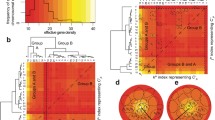Abstract
The recently available DNA sequences from chromosomes 21 and 22 enabled us to define the relationships of different band types with isochores and with gene concentration and to compare these relationships with previous results. We showed that chromosomal bands appear as Giemsa or Reverse bands depending not on their absolute GC level, but on the composition GC level relative to those of adjacent contiguous bands. We also demonstrated that the GC-richest, and gene-richest H3+ bands are characterized by a lower DNA compaction compared with the GC-poorest, gene-poorest L1+ bands. Moreover, our results indicate that the human genome contains about 30,000 genes.
Similar content being viewed by others
References
Bernardi G (1989) The isochore organization of the human genome. Ann Rev Genet 23: 637-661.
Bernardi G (2000) Isochores and the evolutionary genomics of vertebrates. Gene 241: 3-17.
Bernardi G, Olofsson B, Filipski J et al. (1985) The mosaic genome of warm-blooded vertebrates. Science 228: 953-958.
Comings DE (1978) Mechanisms of chromosome banding and implications for chromosome structure. Ann Rev Genet 12: 25-46.
De Sario A, Geigl EM, Palmicri G et al. (1996) A compositional map of human chromosome band Xq28. Proc Natl Acad Sci USA 93: 1298-1302.
De Sario A, Roizès G, Allegre N, Bernardi G (1997) A compositional map of the cen-q21 region of human chromosome 21. Gene 194: 107-113.
Dunham I (2000) The gene guessing game. Yeast 17: 218-224.
Dunham I, Shimizu N, Roe BA et al. (1999) The DNA sequence of human chromosome 22. Nature 402: 489-495.
Dutrillaux B (1973) Nouveau système de marquage chromosomique: les bandes T. Chromosoma 41: 395-402.
Ewing B, Green P (2000) Analysis of expressed sequence tags indicates 35,000 human genes. Nature Genet 25: 232-234.
Federico C, Saccone S, Bernardi G (1998) The gene-richest bands of human chromosomes replicate at the onset of the S-phase. Cytogenet Cell Genet 80: 83-88.
Federico C, Andreozzi L, Saccone S, Bernardi G (2000) Gene density in the Giemsa bands of human chromosomes. Chromosome Res 8(8): 737-746.
Francke W (1994) Digitized and differentially shaded human chromosome idcograms for genomic applications. Cytogenet Cell Genet 6: 206-219.
Fukagawa T, Sugaya K, Matsumoto K et al. (1995) A boundary of long-range G + C% mosaic domains in the human MHC locus: pseudoautosomal boundary-like sequence exists near the boundary. Genomics 25: 184-191.
Gardiner K, Aïssani B, Bernardi G (1990) A compositional map of human chromosome 21. EMBO J 9: 1853-1858.
Hattori M, Fujiyama A, Taylor TD et al. (2000) The DNA sequence of human chromosome 21. Nature 405: 311.
Kirsch IR, Green ED, Yonescu R et al. (2000) A systematic, high-resolution linkage of the cytogenetic and physical maps of the human genome. Nature Genet 24: 339-340.
Liang F, Holt I, Pertea G, Karamycheva S, Salzberg SL, Quackenbush J (2000) Gene Index analysis of the human genome estimates approximately 120,000 genes. Nature Genet 25: 239-240.
Macaya G, Thiery JP, Bernardi G (1976) An approach to the organization of eukaryotic genomes at a macromolecular level. J Mol Biol 108: 237-254.
Mouchiroud D, D'Onofrio G, Aïssani B, Macaya G, Gautier C, Bernardi G (1991) The distribution of genes in the human genome. Gene 100: 181-187.
Pilia G, Little RD, Aïssani B, Bernardi G, Schlessinger D (1993) Isochores and CpG islands in YAC contigs in human Xq26.1-qter. Genomics 17: 456-462.
Roest Crollius H, Jaillon O, Roest Crollius H et al. (2000) Estimate of human gene number provided by genome-wide analysis using Tetraodon nigroviridis DNA sequence. Nature Genet 25: 235-238.
Saccone S, De Sario A, Della Valle G, Bernardi G (1992) The highest gene concentrations in the human genome are in T-bands of metaphase chromosomes. Proc Natl Acad Sci USA 89: 4913-4917.
Saccone S, De Sario A, Wiegant J, Raap AK, Della Valle G, Bernardi G (1993) Correlations between isochores and chromosomal bands in the human genome. Proc Natl Acad Sci USA 90: 11929-11933.
Saccone S, Caccio S, Kusuda J, Andrcozzi L, Bernardi G (1996) Identification of the gene-richest bands in human chromosomes. Gene 174: 85-94.
Saccone S, Federico C, Solovei I, Croquette MF, Della Valle G, Bernardi G (1999) Identification of the gene-richest bands in human prometaphase chromosomes. Chromosome Res 7: 379-386.
Yokota H, Singer MJ, van den Engh GJ, Trask BJ (1997) Regional differences in the compaction of chromatin in human G0/G1 interphase nuclei. Chromosome Res 5: 157-166.
Zoubak S, Clay O, Bernardi G (1996) The gene distribution of the human genome. Gene 174: 95-102.
Author information
Authors and Affiliations
Rights and permissions
About this article
Cite this article
Saccone, S., Pavliček, A., Federico, C. et al. Genes, isochores and bands in human chromosomes 21 and 22. Chromosome Res 9, 533–539 (2001). https://doi.org/10.1023/A:1012443217627
Issue Date:
DOI: https://doi.org/10.1023/A:1012443217627




